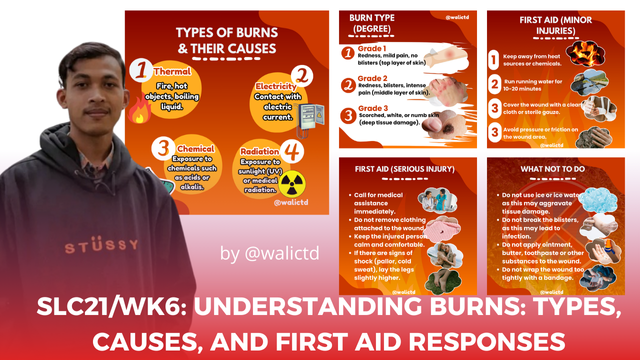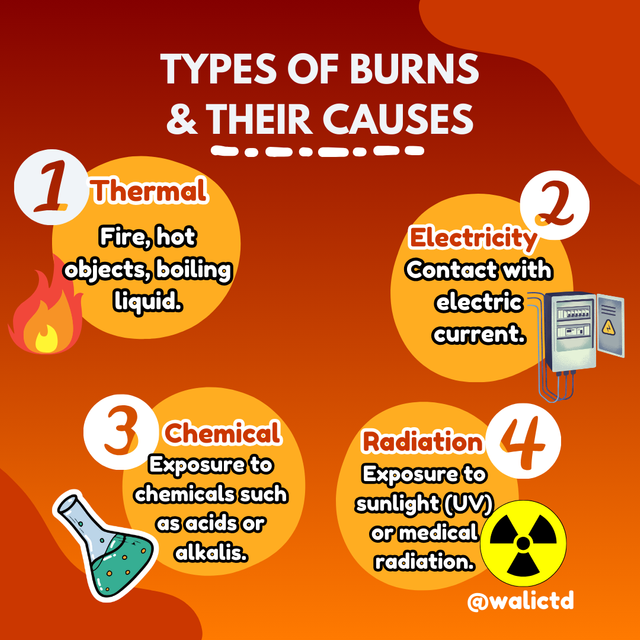Hi friends, after reading around I am interested in participating in an amazing challenge this week. The challenge is titled: "Understanding Burns: Types, Causes, and First Aid Responses" by Dr @abdu.navi03 and Dr @huzaifanaveed1 following the contest link.
 |
|---|
Previously I also invited other friends such as Mr. @irawandedy, Mr @muzack1 , sir @sisol and my friend @cymolan.
| Question 1: |
|---|
| Write a detailed first aid response for the following scenario: |
| “You witness a child accidentally spill hot tea on his arm. What immediate steps would you take? What actions would you avoid? |
| Include consideration of the severity of the burn and explain your reasoning.” |
When I see a child who may accidentally get hot tea on his arm or where his other limbs are, then the first step I will do is to keep the child away from the heat source. Then, I will wash the arm or where the hot tea was using running water, remember the water is normal temperature which means not ice cold water, as for the length of time to wash is about at least 10 minutes. By washing with this water, it will certainly make the child soothe the burned skin and most importantly, it can prevent further damage.
Next, I will cover the wound on the arm or part of the member that was exposed to the hot tea by using a clean cloth with the aim that the skin is protected from dirt or infection. Remember I don't just leave it like that, because we will always check how bad the wound is, if it's just red then we assume that it's just a minor burn. However, if the arm or member affected by the hot tea becomes blistered or the skin looks white or practically scorched, then immediately take it to the doctor.
We need to remember that when the wound is severe, we should not apply toothpaste, or oil, or anything else to the burn, which will usually make the wound worse. And we should not use ice cubes to relieve pain, which with cold temperatures will make the wounded skin worse. If there is a blister on the burn, then we just need to leave it alone and not break it immediately, which is a natural protection for our skin.
Lastly, I would make sure that the child who was exposed to the hot tea remains calm, and if the wound looks severe then we immediately seek medical assistance so that it can be treated further.
| Question 2: |
|---|
| “A worker in a warehouse suffered an electrical burn after touching an exposed electrical wire. The burn site shows entry and exit points, with damage to the skin and underlying tissue. What first aid measures should you take, and what important steps should you avoid? How is it different from treating thermal burns?” |
If I found a worker with electrical burns, the first step would be to make sure the location is safe first. Next, I would make sure that the power source is off or I could move the worker so that they are no longer connected to dangerous wires, but we need to remember that we should never touch an electrocuted person directly if the power source is still active, because we will usually get stung too.
Then I would look for and use a tool that certainly cannot conduct electricity, for example I would take a wooden or plastic stick, in order to separate it from the source of electricity. If it is safe, I will immediately seek medical help because I know that injuries caused by electricity often cause internal damage to the victim, so it cannot be determined from the outside.
While waiting for help, I will check that the electrocution victim is still breathing. If not, then we need to perform chest compressions or what is commonly called CPR. Now if he is conscious, I just need to help him stay calm, and of course not let him get up or move too much. What we need to know is that, in every burn caused by electricity it generally has an entry point, so we need to check both places to keep them clean. Next we just need to cover the wound with a clean cloth, but do not apply anything to the wound.
There are some things to avoid such as washing the burn with water. Do not break blisters if there are any or touch the burn directly. The point is to focus on safety and then call for help.
| Question 3: |
|---|
| “A worker in a factory accidentally spilled strong acid on his arm, which caused pain, redness, and blisters. A coworker tries to clean it with water but realizes the burn is spreading.” |
| a. Identify the type of burn. |
| b. What went wrong during the initial first aid? |
| c. Propose the correct first aid steps and explain why each step is important. |
If you find a worker with strong acid on his arm, then of course this kind of injury is classified as a chemical burn. The difference between ordinary burns and those caused by chemicals is that those caused by chemicals will continue to damage the tissue. We need to know that strong acids need a lot of time to completely disappear, and so do not stop washing it with running water (not cold water or ice water), because if it is not long it will make the burn spread.
A good step is to immediately remove clothing and any items that may have been exposed to the strong acid, but be careful not to let the chemical touch other parts of the body. Next, we need to wash anywhere that the acid hits with running water for at least 20 minutes, remember not to stop. this is all important in order to dissolve and be able to clean the remnants of chemicals that hit the body.
The next step is to cover the wound using a piece of clean cloth, keep in mind not to press too hard. The last step is to make sure to call for medical help as soon as possible or take him to the hospital because chemical burns will generally make severe damage to the tissue deeper than it looks.
| Question 4: |
|---|
| You are a first responder in a rural area. Two people were injured in a house fire: |
| Person A has extensive third degree burns but is conscious and calm. |
| Person B has second-degree burns on both legs and is in severe pain. |
| You can only help one person immediately due to limited resources. |
| Who would be your priority, and why? Support your decision with medical and ethical considerations. |
In this situation, we need to prioritize Person B, who has second-degree burns on his legs and is in severe pain. The reason why we need to prioritize Person B is because we need to know that second-degree burns are usually more risky which can cause shock from the intense pain, so if it is not treated immediately, it is feared that it will lead to a more serious condition. The first aid that is done is to cool the wound and reduce the pain, of course, the impact will be felt immediately.
As for Person A, who had third-degree burns, although they were very serious, but at that time he was still conscious and in a calm condition, so his condition was still stable. This type of burn is usually not too painful as the nerves are damaged, and the treatment is more complex, so it is better to go to the hospital immediately.
Then we can conclude to focus on Person B first. We need to cool the wound with clean, running water for at least 15 minutes, and then cover the wound with a clean cloth. In his condition we need to make sure that he does not go into shock. Person A is still cared for, where we give him mental support, and we need to cover the wound if there is time. The point is, this kind of virtue is made so that both have the best chance of surviving, in a sudden situation.
| Question 5: |
|---|
| Make an infographic about flare management. Include the following: |
| a. Types of burns and their causes (electrical, thermal, etc.) |
| b. Types of burns (1st, 2nd, and 3rd degree) |
| c. First aid measures in minor and severe burns |
| d. What NOT to Do During Burn First Aid.” Use visuals and short explanations for each point. |
| Here is the tabular version for Burn Management: |
|---|
| Types of Burns & Their Causes |
 |
| Types of Burns (Degree) |
.png) |
| First Aid (Minor Injuries) |
.png) |
| First Aid (Severe Injury) |
.png) |
| What NOT to do |
.png) |
@walictd

Terimakasih telah mengundang saya dalam topik ini, sejujurnya pembelajaran ini merupakan rutinitas dalam pekerjaan saya di rumah sakit, tapi saya belum mampu mengembangkan dalam bentuk tulisan sehingga hasil penulisannya menarik untuk dibaca.
Akan butuh waktu yang cukup lama untuk menulis, mengingat beban kerja yang padat diakhir tahun, saya harus fokus pada pekerjaan saya didunia nyata.
Downvoting a post can decrease pending rewards and make it less visible. Common reasons:
Submit
Itulah sebabnya saya mengundang bapak, hehehe.
Tidak apa-apa jika tidak sempat, akhir tahun memang semua pekerjaan baik di dinas pemerintahan atau swasta masing-masing mempunyai kesibukan yang luar biasa, baik dalam menyelasaikan laporan tahunan ataupun persiapan kelanjutan di tahun baru. Yang penting sehat selalu dan semangat terus.
Terimakasih telah singgah pak....
Downvoting a post can decrease pending rewards and make it less visible. Common reasons:
Submit
Student Name: @walictd
Overall grade: 8.6
Plagiarism Check: Pass
AI Use: no
General Feedback: The student has shown a good understanding of this week's course. I definitely enjoyed reading your article. There were a few shortcomings which I'm sure will be avoided in the upcoming posts.
Thank you.
Regards,
@huzaifanaveed1
Downvoting a post can decrease pending rewards and make it less visible. Common reasons:
Submit
Thankyou sir 🙏🙏
Downvoting a post can decrease pending rewards and make it less visible. Common reasons:
Submit
https://x.com/walictd/status/1864962430499164349
Downvoting a post can decrease pending rewards and make it less visible. Common reasons:
Submit
@tipu curate
Downvoting a post can decrease pending rewards and make it less visible. Common reasons:
Submit
Upvoted 👌 (Mana: 5/7) Get profit votes with @tipU :)
Downvoting a post can decrease pending rewards and make it less visible. Common reasons:
Submit
Thankyou friends
Downvoting a post can decrease pending rewards and make it less visible. Common reasons:
Submit